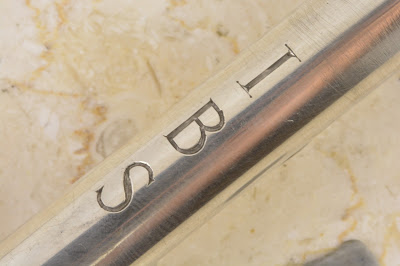This article has been edited and included in The Leadhead's Pencil Blog Volume 4; copies are available print on demand through Amazon here, and I offer an ebook version in pdf format at the Legendary Lead Company here.
If you don't want the book but you enjoy this article, please consider supporting the Blog project here.
Yes, this monster is a Hicks:
This one has it all. First, let’s put it next to a full-sized Hicks stockbrokers’ pencil to give you a sense of scale:
To change leads, the front portion of the barrel can be pulled forward:
Enameled arrows, concealed when the pencil is being operated, are revealed to indicate the colors available:
Twist the lower barrel to line up the color you want with the embossed arrow on the upper barrel, then push in the lower barrel to advance the lead:
Except this one has a twist . . . literally. With most multicolor pencils in this genre, what “advances” is merely a wire with a stick of lead on the end – how much lead you want to advance is controlled by how far in you push the lower barrel. This one is different: the barrel is pushed into place to advance an entire pencil mechanism, which twists to advance or retract the lead.
In addition, there’s three more interesting features to consider with this one, all of which are on the cap:
This one is stamped “Cartier” – it’s fascinating that the high end jeweler would associate itself with a multicolor “trick” pencil, a specialty normally found running in less highbrow circles. Note also the faint serial number or model number, 8870, imprinted perpendicular to the other lettering.
And, of course, note the “PAT. PEND.” stamp.
I’m going to stop for a minute and toot my own horn for a great book I’ve written that you’ve probably never read: American Writing Instrument Patents Volume 2: 1911-1945. No, this one doesn’t stand a chance of reaching The New York Times’ best sellers list – but it is a highly specialized and useful tool that I wrote for myself for a very specific purpose.
This precise purpose.
The book organizes a spreadsheet of thousands of writing instrument patents I’ve compiled into five sections, ordering them first by date and number, then by description, inventor, assignee and last, by location. In the “by description” section, I’ve grouped together all patents for “Mechanical pencil (multicolor),” so instead of spending hours combing through all of the insane categories into which something like this might have been filed, I can simply go down the list of patents I’ve already indexed.
It’s still a pretty long list, almost two pages’ worth, but with the 30th patent on that list I hit paydirt:
Halsey Monroe Larter applied for patent number 1,808,171 on November 7, 1929, just after the stock market crash that triggered the Great Depression; his patent was awarded on June 2, 1931 and assigned to Larter & Sons of Newark, New Jersey. As impressive as this pencil is, the unfortunate timing of its introduction as a Hicks-made, Cartier luxury accoutrement leaves no doubt in my mind of how extraordinarily rare these pencils are.
The patent drawings illustrate a number of features shown on my pencil, from the rounded top to the shape and relative size of the indicator marks on the barrel. However, since the patent was assigned to Larter & Sons rather than to Hicks, I tunneled a bit deeper, turning to the “inventor” section of my book, and I found that Halsey Monroe Larter has three writing instrument patents to his credit, with this being one of them. The other two are design patents, numbers 84,352 and 84,353, and both are assigned – you guessed it – to William S. Hicks’ Sons:
Larter & Sons was a New York jewelry firm on Maiden Lane, founded in 1865. According to the company’s obituary, published in National Jeweler on January 5, 2015, the company closed its doors on November 26, 2014.












No comments:
Post a Comment